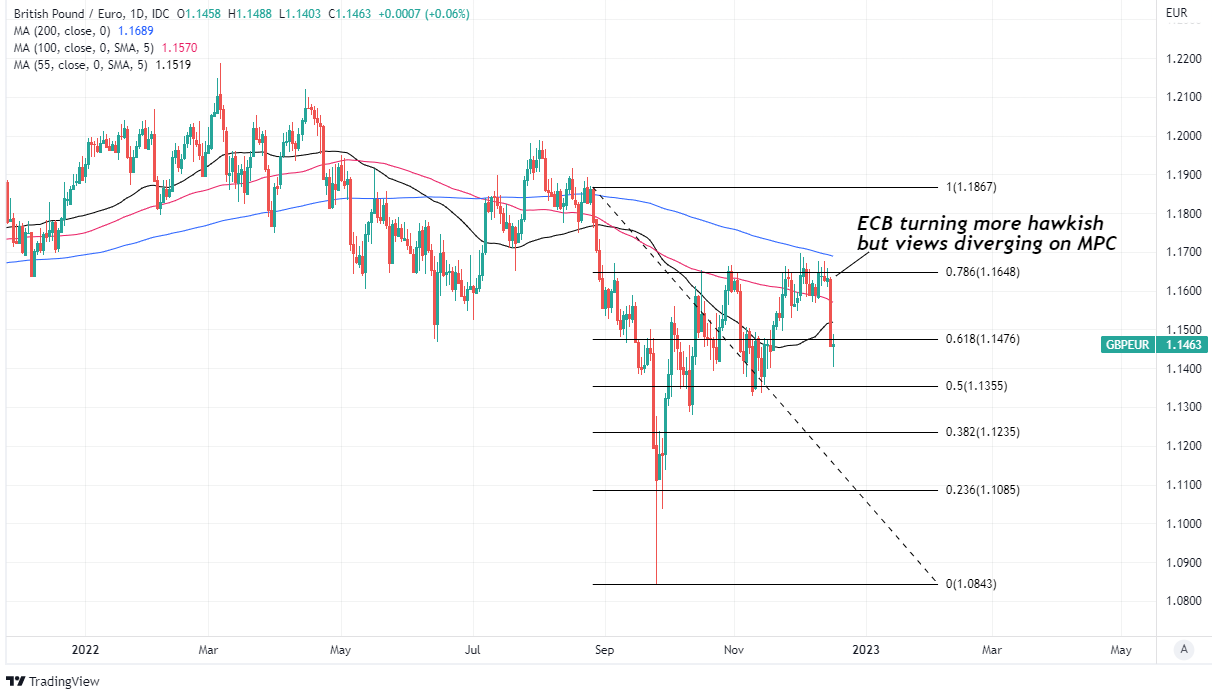GBP/EUR Week Ahead Forecast: Position Squaring Could Support
- Written by: James Skinner
-
- GBP/EUR looking for a foothold around 1.1450
- Could benefit from risk reduction into holidays
- But bleak economic outlook remains headwind
- Sparse calendar leaves global factors in focus

Image © Adobe Images
The Pound to Euro exchange rate (GBP/EUR) fell heavily last week and still faces numerous medium-term headwinds but could be likely to find its feet around 1.1450 over the coming days if risk reduction ahead of the forthcoming holiday period leads the speculative market to cut back bets against Sterling.
Sterling unwound much of its recent recovery against the Euro last week after the European Central Bank (ECB) adopted a notably more hawkish stance barely an hour after minutes of the latest Bank of England (BoE) decision revealed division and dissent on the Monetary Policy Committee (MPC).
"2 wanted no hike at all, 6 wanted +50, and 1 at the extreme wanted +75)," says Stephen Gallo, European head of FX strategy at BMO Capital Markets.
"That split balances out as a dovish hike (two zeros outweigh one 75," Gallo writes in a Friday market commentary.
The BoE raised Bank Rate for a ninth time, taking it up to 3.5%, but waning support for continued increases from MPC members left Sterling vulnerable to a more buoyant Euro, which benefited soon after when the ECB said its own interest rates could yet rise further than financial markets expect.
Above: Pound to Euro rate shown at 2-hour intervals alongside EUR/USD and S&P 500 stock index future.
The BoE decision came as a flurry of official figures warned of a deteriorating economy while also making clear the scale of the challenge faced by the BoE as it seeks to correct the erosion of purchasing power that has resulted from a double-digit inflation rate that remained far above the 2% target in November.
"The front end of the policy statement was littered with comments about the slowdown in household demand," Gallo says in a Friday market commentary.
"The GBP also has to contend with the risk that the BoE's forecast for inflation proves too optimistic, leading the Bank to under-tighten policy," he adds.
Office for National Statistics figures revealed further signs last Tuesday of the labour market having begun to soften around the turn of the quarter while retail sales figures indicated an outright downturn in consumer spending and inflation came in at 10.7% even after falling by almost half a percentage point.
The high level of inflation, which remained above 6% even if food and energy items are removed from the basket for which prices are measured, means the BoE is likely to remain under pressure to continue raising interest rates up ahead and irrespective of the condition of the economy.
Above: Pound to Euro rate shown at daily intervals with Fibonacci retracements of August slump indicating possible areas of technical resistance for Sterling. Selected moving-averages denoted possible support and resistance. If you are looking to protect or boost your international payment budget you could consider securing today's rate for use in the future, or set an order for your ideal rate when it is achieved, more information can be found here.
"CPI inflation fell to 10.7%, from 11.1% in October, thereby undershooting the consensus and the MPC’s forecast in November’s Monetary Policy Report, both 10.9%," writes Samuel Tombs, chief UK economist at Pantheon Macroeconomics, in a Friday research briefing.
"The MPC will not relax just yet; November's good news needs to be repeated for a few more months. But by its mid-March meeting, with three more CPI reports to hand, we think the Committee will be convinced that the headline rate is on track to fall back to 2% in 2024," he adds.
Tombs forecasts sharp declines in inflation next year and so also projects that the BoE will stop raising Bank Rate when it gets to 4% in the months ahead but the prospect of borrowing costs rising further amid a sharp economic slowdown is an almost surefire headwind for the Pound,
Sterling could benefit in the short-term including this week, however, from any position-squaring in the speculative market where participants and punters might be likely to reduce risk ahead of the festive holiday period and where Sterling has been one of the biggest 'shorts' over recent months.
Conversely, the Euro is one of the few currencies in which the speculative market is actually 'long' and so may be susceptible to underperformance.
Above: Pound to Euro rate shown at daily intervals with Fibonacci retracements of September recovery indicating possible areas of technical support for Sterling. Selected moving-averages denoted possible support and resistance. To optimise the timing of international payments you could consider setting a free FX rate alert here.













